As name indicates ectoparasite means the parasites which are lived on the body or outside the body of animal on the skin are called ectoparasites. Lice, tick, mites, fly, flea etc called as external parasite. External parasites depends on the host for feeding and reproduction purpose. Most of the external parasite also acts as biological vectors, mechanical vector for transmission of the disease to the farm animals. In India, farm animals are mainly cattle, buffaloes, sheep and goats and sometimes pigs. Usually small scale farmer rear the farm animal in the shed and for feeding they goes to grazing land. Most of the ectoparasites especially flies lives on the stagnant water as well as in the green grass. When the farm animal goes for grazing they attach the body for feeding and they lay egg on the cut or wounds or abarrations on the skin. Mainly ticks live on the body of animals especially on ear pinna, base of tail, vulva, base of the horn and ventral part of body. Mites are usually found inside the skin areas like ear pinna, dorsal part of body, tail, head and neck. Lice located on the hairs base, shaft of the hair and lice are highly host specific. Flea and fly found on the ventral side of the abdomen. These are mainly cause economic loss to the farmer in many ways.
Types of external parasite
Ticks: The body is oval shape consist of cepahlothorax and abdomen, no antena. Its belongs to the class Arachnida subclass Acari, family Ixodidae which is hard tick (ex: Amblyomma, Anocentor, Bhoophilus, Hyolomma, Ixodes, Rhipicephalus) and Argasidae which is soft tick (ex: Argas persicus, Ornithodorus lahorensis).Ticks will suck the blood and causes anaemia when they infest severely. Ticks acts as biological vector for the diseases like Thelieriosis and Babesiosis.
Mite: These are belongs to the class Arachnida subclass Acari, these are the small that is less than 1mm in length, unsegemented body and cephalothorax. Seen in the microscopic view. Infestation caused by mites known as mange. It will cause severe irritation on skinnand nuisance
Lice: It’s come under the order: Phthiraptera, these are obligate parasite. These are the flattened body, length 0.5mm to 6mm , no oceli. These are divided into two group sucking louse means they took nourishment from feeding from sebaceous secretion to body fluid of host. Chewing louse are scavengers, feed the skin, fragment of hair, feathers and debris of the body.Lice are highly host specific.
Flea: These are the flightless insects belongs to the order siphonaptera. Flatteed, strong claws, brown, 3mm long. These feed the blood of the host. They jump upto 20-30cm with hind legs.
Flies: These are the insects belong to the order Diptera. These are having wings, mobile head, compound eye, piercing and sucking mouth parts. (horn fly, tabanidae, culicoids). These are act as mainly mechanical vector for bacterial, viral, parasitic diseases to farm animals. These are mainly seen in the summer. They also divide into biting flies (stable flies, horse flies) and nuisance flies (horn flies face flies).
Effect of external parasite on farm animals
- These are mainly bite and suck the blood causing severe anemia to the animals. Example: Ticks and lice.
- While grazing of animals flies noise irritate during feeding and animal not take food properly causing debility and weakness. Example: Horn flies, Forest flies.
- In winter season, lice population is much more on the body; they will suck the blood and causing anemia to the animals. It will also cause irritation on the body and hair loss observed.
- Mites causes a condition in animals called mange, which affect mainly on head, legs, body, tail region causing skin irritation and form crusted over the skin and causes the hair, wool loss. Infected area becomes itches and scratched over body, for this animal not feed properly. Hide damage saw in cattle and goats.
- Tick paralysis, tick pyemia and tick toxicosis caused by the ticks will have deleterious effect on health of animals.
- Flies, mosquitoes will bite and suck the blood resulting in nuisance during feeding leads to fall in health and production.
- Bites can cause skin allergy, anaphylaxis leading to immune reactions.
- Flies will lay egg on the wound or freshly cut open surface of skin leading to myiasis resulting in blood loss, nuisance, inflammation, pyrexia and fall in production.
- External parasites acts as vectors for many diseases like Sheep ked transmits Blue tongue disease mechanically, fleas acts as vector for Diphilidiun caninum Tape worm, ticks transmits Staphylococcal infections, flies transmits Trypansomiasis and Lumpy skin disease leading to severe production and economical losses.
Cattle And Buffaloes
Ticks: it mainly effect the health status of the animal. It causes severe blood loss causing anemia. Dull rough hair coat, ticks also acts as vectors for many diseases.
Mites: They are mainly 3 types
- Psoroptic mange: Highly contagious in sheep and goat also known as sheep scab.
- Sarcoptic mange: Highly contagious in goat and spreads through contact of affected animals.
- Demodectic mange: Causes damage in skin and disease found in all domestic animals also known as hair follicle mite.
These causes mange and scabies, skin lesion and irritating the animal. Severely infested animals’ loss their body condition becomes debilitated and fall in yield in milking cattle. Spreads mainly through contact of affected animals.
Louse: They are mainly 2 types
- Sucking lice: They have strong mouth parts for sucking of blood.
- Biting lice: They feed on organic material found on epidermis and hair. They bite intensely on skin.
Lice infestation causes rough dull hair coat and unthriftiness because they were irritating and causing damage to the hair shaft and base of the hair coat resulting in falling of hair. It causes rubbing so that often removing of patches of hairs observed, bruising skin and also damages fences and equipment also seen.
Sheep and Goat
Sheep and goat affected with ecto parasites having anemia, irritability, dermatitis, debility, immune reaction likely hypersensitivity etc, focal haemorrhages, inoculation of toxin, blockage of orifices. (ears, anal region etc) In sheep Oestrus ovis flies causes nasal myiasis. Sheep ked will transmits BT virus mechanically.
List of external parasites acts as vectors for below diseases
| S.N. | External parasite | Transmission of disease |
| 1 | Ticks | Thileriosis, Babesiosis, Anaplasmosis, Staphylococcal infections, Lumpy skin disease. |
| 2 | Fleas | Diphylidium caninum, Rickettsia typhi, Yersiniosis. |
| 3 | Sheep ked | Blue tongue |
| 4 | Culicoides | Blue tongue |
| 5 | House flies | Transmits E Coli, Salmonellosis. |
| 6 | Face flies | Pink eye disease, Thelaziasis |
| 7 | Lice | Swine pox virus, Trichophytan spp, Anaplasma marginale. |
| 8 | Tse tse flies | Trypanosoma spp |
| 9 | Mosquitoes | Dengue fever, Chicken gunya fever, Japanese encephalitis, Yellow fever, Fileriosis. |
| 10 | Sand flies | Leishmeniasis |
| 11 | Horse flies | Anthrax |
Diagnosis Of External Parasite
Based on the observation: Based on the clinical signs like scratching, shaking the head tail, and rubbing to the wall, tree are the indication of animals having external parasites such as flies, mite, lice and flea etc.
- Careful examination of skin of animals for presence of flea dirt, nits of lice, fleas, ticks and lice.
- Some of ectoparasite are located on horns (horn flies), faces( face fly) will observed carefully.
- Some of the bots example fly bots observed on grass as well as microscopic observation for identification.
- Myasis can be identified fresh wound with blood oozing and rotten smell observed.
Microscopic examination:
- Mites are not visible in the naked eye so skin scrapping sample taken and processed and observed in microscope for identification of causative agent and differentiate with other skin infection like fungi and bacterial origin.
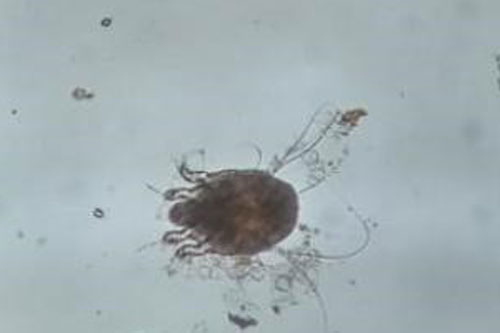
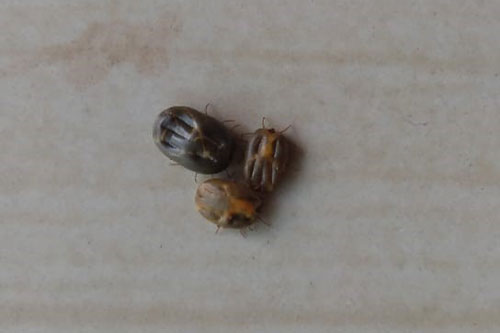
Economic Effect of ectoparasite to the farmer
- Reduce the productive and reproductive performance of the livestock.
- Flies irritate the animal while grazing, which reduce the feeding intake and become hide and bone condition.
- External parasites will feed on blood causes anemia which in turn causes retarded growth in calves, , fall in milk yield in adult female animals and loss of draft power in male animals.
- Due to bites of external parasites hide quality of animal goes down.
- External parasites will acts as vectors of so many diseases leading to potential economical losses from diseases in terms of morbidity and mortality.
- Cost of medication for the control and treatment of external parasites will be a financial burden to farmer.
Treatment and control
- Before external application of medicated solution to animals, animals should be offered with good amount of fresh water and animal should not have open wounds or cut open surfaces. Open wound or skin surface will potentiate the toxicity of acaricides to animals.
- Pour on applications should be used for external parasites like ticks and lice as per veterinarian instruction.
- Dipping of small animals with medicated solution should be followed.
- Hand spraying of medicated solution on animals also followed.
- External acaricides like Amitraz, Butax are used for lice, ticks and mange.
- Pareneteral preparations like Avermectins should be used for Mange, ticks and lice.
- Medicated shampoos and medicated flea collers should be used for the control of lice and fleas.
- Electricity operated fly traps used in the animal shed to control the fly nuience.
- Acaricides impregnated ear tags will helps in reduce the external parasite burden.
- Powder preparations like Notix used for the control of ticks.
Some of the acaricide used for control of external parasite as
- Organophosphorus: Coumaphos, Trichlorfon, Diazinon, Diaoxathion, Fentahion, Malathion, Chlopyrifos
- Chlorinated Hydrocarbons: Chlorinated Hydrocarbons, Thioden
- Carbamates: Carbaryl, Promacyl
- Pyrethrins And Pyrethroids: Deltametrin, Cypermetrin
- Avermectin: Doramectin, Ivermectin
Some new techniques used for acaricide in control of ectoparasite
- Plunge dipping used for farm animals.
- Dust and back rubber all over the body for livestock.
- Insecticidal ear tags available for cattle for the control of external parasite.
- Pour-ons and backliners nowsdays popular in field level for all animals for taking care of safety and easily application to the famers.
- Shampoos, soap, lotion with milder doses available for small animals.
- Spraying and powder form also available in market for control of ectoparasite.
- Injectible and oral form also available like ivermection, doramection for get rid of external parasite.
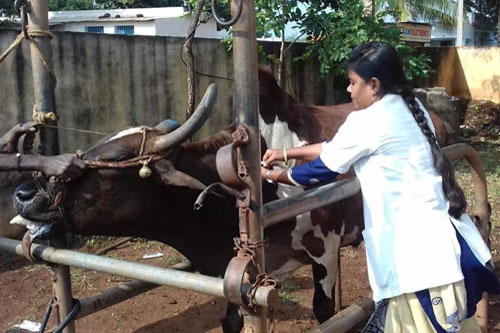
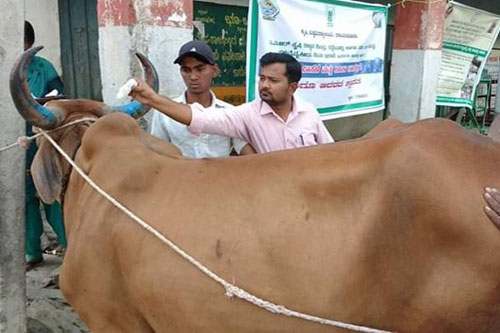
Prevention of external parasite
- Regular grooming and washing of animals.
- Follow clean and hygienic practices in the farm.
- Follow strict bio-security in the farm
- Avoid accumulation of water, urine and dung material in and around the farm
- Follow rotational grazing method in the pasture.
- Immediate attention should be given to wounds to avoid myiasis.
- Eliminate the source of external parasites
- Cattle shed should be protected with green net shed.
- Proper disposal of urine and dung in the animal shed.
- Proper disposal of carcass and animal related products.
Reference
- external parasites of ruminants, vikaspedia.in
- Technical Bulletin no 41 Control of external parasites ofSheep and Goats Ethiopia sheep and goat improvement programme.
- External parasites in Cattle, A fact sheet for the Canadian Cattle industry Jillian Simpson
- Ectoparasites and Classification C.E. Hopla, L.A. Durden, J E Keirans 1994.
- External parasites of dairy cattle, C.M.Christensen, Journal of dairy science, vol.65.No.11, 1982
- MSD veterinary manual
- Wikipedia
|
The content of the articles are accurate and true to the best of the author’s knowledge. It is not meant to substitute for diagnosis, prognosis, treatment, prescription, or formal and individualized advice from a veterinary medical professional. Animals exhibiting signs and symptoms of distress should be seen by a veterinarian immediately. |


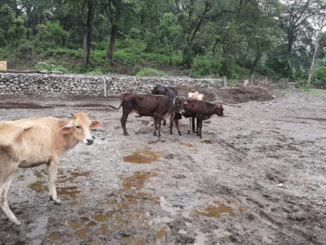
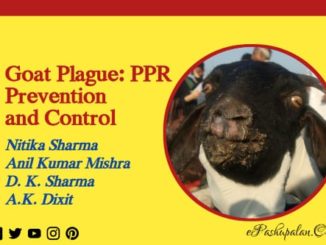
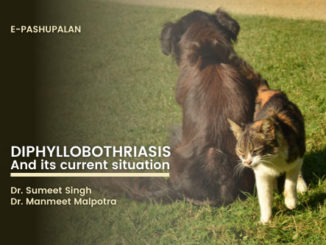

Excellent information of infestation of ectoparasites in livestock
very nice information
Nice article with wonderful information
……
Nic article